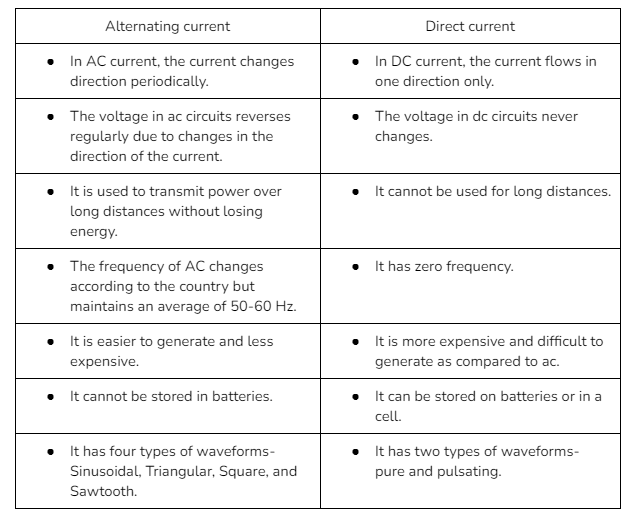Alternating current (AC) is an electric current that flows in both directions at regular intervals. It begins from zero, reaches its peak, decreases to zero, changes its direction, and repeats the whole cycle infinitely. The interval of time between the completion of a precise value of two successive cycles is known as a period. The total number of periods or cycles per second is known as frequency. The highest value in either direction is known as the amplitude of the alternating current. AC current is preferred over direct current, as it can transfer power over a greater distance without losing a lot of energy due to resistance.
Alternating current produces positive and negative values of the same degree.
Usually, three types of wires are used to supply AC to equipment:
- The hot wire is used to transmit the power.
- The neutral wire is connected to the ground and is used to create a path for the current to return to the hot wire.
- The third wire is connected to the equipment. It is also connected to the ground to provide safety and curb electric shocks.
Properties of AC current
The five properties of AC current are:
- Amplitude- The highest value of current in either direction is known as the amplitude of the AC current. It is denoted by either of the two peaks of the sine waves. The voltage level is called peak voltage and can be positive or negative. The positive and negative values denote the direction of the flow of the current.
- RMS- RMS stands for root mean square. It is the commonly used way of reporting and measuring voltage. It is not a peak value but the average value of the voltage.
- Cycles- The interval of time between the completion of a precise value of two successive cycles is known as a period or a cycle. It is produced when the AC generator completes one full revolution.
- Frequency- The total number of periods or cycles per second is known as the frequency.
- Peak to peak- It is the highest positive and negative amplitudes on the sine wave. The value of peak to peak is double that of the amplitude. It is the maximum voltage available.
Uses
- AC current is used to provide power for domestic and commercial purposes.
- Audio and radio signals that are carried on electrical wires use alternating current.
- It is also preferred for powering electric motors.
- It is used in many household appliances like refrigerators, dishwashers, etc.
RMS value of AC current
The full form of RMS is the Root Mean Square. It is the commonly used way of reporting and measuring voltage. It is not a peak but the average value of the voltage. It is the actual value of the alternating current that describes the energy transfer capacity of the ac source. The RMS value of the AC current is equal to the root two times the peak value. The rating of all the electrical appliances is done according to the RMS value. The RMS value is never negative and is usually greater than the average value except in the case of rectangular waves, where it is equal to the average value.
Formula for calculating the RMS value of AC current or voltage-
IRMS = 0.707 x peak value of current
VRMS= 0.707 x peak value of voltage
Waveforms of alternating current
Waveforms are used to represent the flow of AC current over a graph. Faraday’s law of electromagnetic induction explains the science behind waveform generation clearly. It is generally represented using sine waves. However, there are four types of waveforms. These are-
- Sine Wave– It is also known as a sinusoidal wave. They have increasingly rising waveforms with sharp peaks. It is the most commonly used wave. This is because the sine wave embodies a smooth transition of the coil or magnet. It is also used to distinguish between certain inverters.
- Square waves- They are used to represent electrical signals and clock signals in digital electronics. The waves are always symmetrical as the duration of each swing is equal. They have vertical up and down with flat tops at the peak. They derive their name from their flat tops. They can be generated with simple circuits easily.
- Triangular waves- Triangular waves have slow rising and fall time. They have sharper peak edges as compared to sine waves. They are equally periodic.
- Sawtooth waves– The name is derived from its shape, which looks like a sawtooth from the top. It has two types- the positive ramp with slow rise and fast steep fall and the negative ramp with fast rise and slow steep fall.
Difference between alternating current and direct current

Conclusion
Alternating current is the type of current in which direction changes at regular intervals. It is preferred over DC current as it can transfer energy over long distances without losing energy. It is the most commonly used current for commercial purposes. It cannot be stored in batteries. It has four types of waveforms- Sinusoidal, Triangular, Square, and Sawtooth.
 Profile
Profile Settings
Settings Refer your friends
Refer your friends Sign out
Sign out







